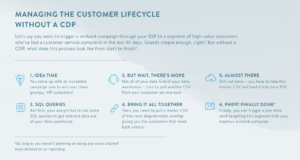Why You’re in Desperate Need of a CDP
December 21, 2018What makes a marketing campaign effective? Personalization.
What’s essential to drive effective personalization? Customer data.
That said, just collecting customer data doesn’t mean you’re at the end of your journey to successful marketing; it’s just a step in the right direction. How you utilize this collected data is incredibly important.
First and foremost, your data is not stored in one place. Email engagement data, on-site/in-app activity, transactional data, etc. all live in different places. And what’s worse, they all have different data structures with no common identifier, meaning linking all of your disparate data sources requires painstaking manual work. In other words, if John Smith were spending time on your website and separately opened an email, it’s often difficult to tie both actions to him.
Point is: it’s very hard to get a unified customer view when all the customer data you’ve obtained is scattered, and it’s even harder to build a relationship with your customer without this cohesive, single customer profile. The difference really comes from having one coherent conversation with your customer instead of multiple rudimentary ones that prove both ineffective and a little disorienting.
This is where a Customer Data Platform, or a CDP, comes into play. By aggregating all of your customer data into one place, a CDP allows you to fully understand customer behavior across all touchpoints. But the real difference between CDPs and other CRM or data management platforms is that CDPs are designed specifically for marketers.
Let’s take a peek into what managing the customer lifecycle without a CDP look like.

If that sounds difficult to you, you’re right. This is where CDPs come in.
Since CDPs are meant to be marketer-managed, you no longer need to rely on engineering resources to create and deploy personalized marketing campaigns. Further, the most advanced CDPs support both advanced customer segmentation and actual marketing execution, giving marketers a one-stop-shop for building and targeting audiences across channels.
This kind of power has real revenue impact. A recent McKinsey study focused on the value of CDPs cited a multinational retailer that leveraged customer purchase data alongside on-site activity to trigger targeted messaging to specific segments of customers. The result? The company doubled its email open rate from 10–15% to 25–35%. Similarly, the same study highlighted a travel company that employed the same personalization in their marketing strategy to drive a 10–20% boost incremental boost in conversion rates and customer lifetime value.
A CDP isn’t strictly necessary in order to build this crucial relationship with your customer, boost relevant KPIs, and drive an increase in revenue, but going at it alone isn’t easy. Moreover, there’s a real opportunity cost in doing things the old-fashioned way. Time lost due to manual processes isn’t just a quality of life issue for marketers. Moving slowly here means running fewer tests, optimizing less efficiently, and losing out on the ability to capture opportunities as they arise, all of which have significant revenue implications.
Better personalization is rapidly changing from a nice-to-have into a necessity, but building out these capabilities doesn’t have to be painful. After all, that’s what a CDP is for.
Sounds too good to be true? Give us a shout at hello@simondata.com.


